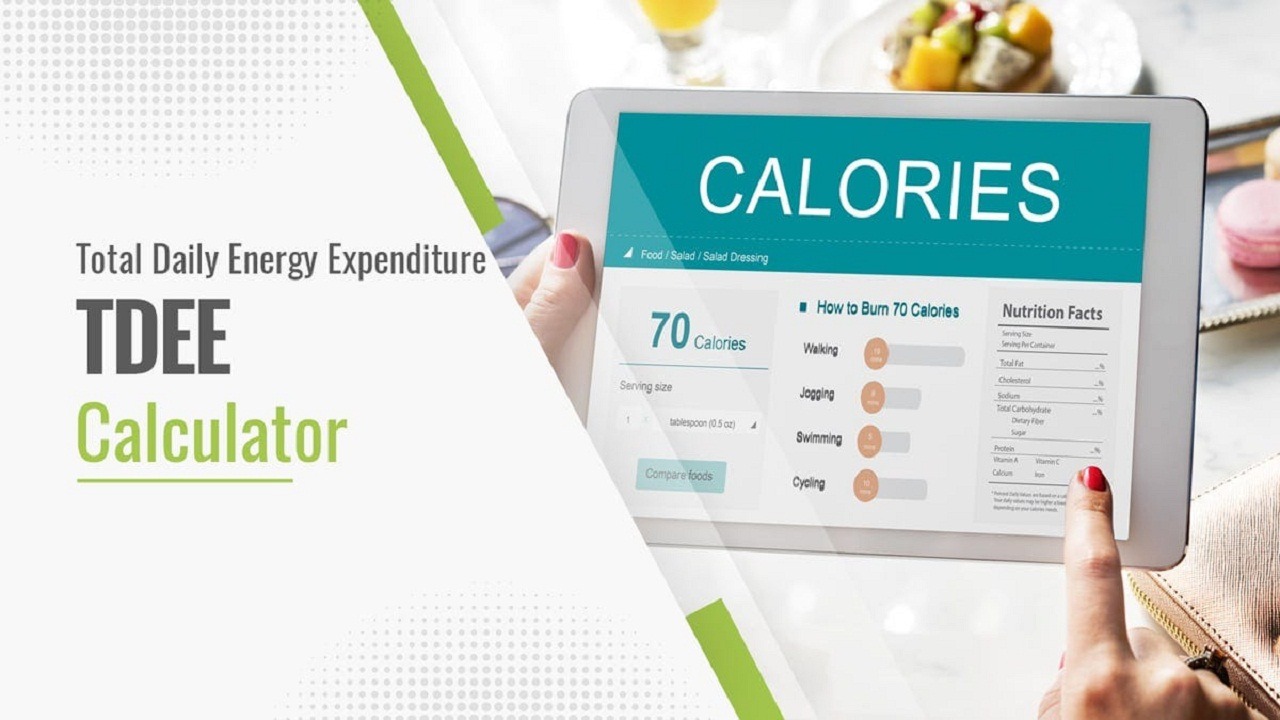Total Daily Energy Expenditure (TDEE): A Comprehensive Guide for Personalized Health and Fitness
Contents
- 1 Total Daily Energy Expenditure (TDEE): A Comprehensive Guide for Personalized Health and Fitness
- 2 TDEE Calculator
- 3 Deconstructing TDEE Components
- 4 Basal Metabolic Rate (BMR)
- 5 Physical Activity
- 6 Thermic Effect of Food (TEF)
- 7 The Crucial Significance of TDEE
- 8 Weight Management Precision
- 9 Nutritional Strategy Customization
- 10 Synergy with Fitness Goals
- 11 Mastering the TDEE Calculator
- 12 Application of TDEE Calculator for Weight Goals
- 13 Weight Loss Strategy
- 14 Weight Gain Approach
- 15 Continuous Monitoring and Adaptation
- 16 The Nuances of Macronutrient Distribution
- 17 Carbohydrates
- 18 Proteins
- 19 Fats
- 20 Real-Life Applications and Success Stories
- 21 Conclusion
- 22 Frequently Asked Questions (FAQs) on Total Daily Energy Expenditure (TDEE):
Embarking on a journey toward better health and fitness requires a comprehensive understanding of your body’s energy needs. Total Daily Energy Expenditure (TDEE) plays a central role in this understanding, encompassing the intricate interplay of Basal Metabolic Rate (BMR), physical activity, and the Thermic Effect of Food (TEF). This in-depth exploration aims to unravel the complexities of TDEE and illuminate how the TDEE calculator can be a transformative tool in tailoring your approach to nutrition and fitness.
Must Check: Steroids for Weight Loss | Mechanisms, Benefits, Results, and FAQs
TDEE Calculator
Deconstructing TDEE Components
Basal Metabolic Rate (BMR)
Your body’s metabolic engine, BMR, signifies the baseline energy expenditure required to maintain essential bodily functions while at rest. Calculated based on factors such as age, gender, weight, and height, BMR forms the foundational element of TDEE. Understanding the intricacies of BMR provides a window into the energy needed for basic physiological functions, such as breathing, circulation, and cellular processes.
Physical Activity
Beyond the resting state, TDEE factors in the energy expended through various physical activities. This encompasses intentional workouts, daily routines, and even spontaneous movements. The level of activity profoundly influences the overall daily caloric requirements. Incorporating a range of activities, from sedentary to extremely active, helps capture the diversity of lifestyles and their impact on energy expenditure.
Thermic Effect of Food (TEF)
TEF reflects the energy expended during the digestion and absorption of nutrients. Each macronutrient (carbohydrates, proteins, and fats) demands a specific amount of energy for processing, contributing to the overall energy expenditure throughout the day. Understanding how different foods influence energy expenditure sheds light on the dynamic nature of TDEE.
The Crucial Significance of TDEE
Weight Management Precision
TDEE serves as a precision tool for those seeking to manage their weight effectively. Whether the goal is weight loss, gain, or maintenance, understanding TDEE provides a personalized roadmap for caloric intake. A thorough grasp of the relationship between TDEE and weight management allows individuals to make informed decisions about their dietary and lifestyle choices.
Nutritional Strategy Customization
TDEE aids in customizing nutritional strategies by determining the ideal distribution of macronutrients. This knowledge empowers individuals to craft a well-balanced diet that aligns with their energy requirements. Considering the individual variations in macronutrient needs ensures that nutritional plans are not only effective but also sustainable over the long term.
Synergy with Fitness Goals
Aligning your exercise routine with TDEE ensures that physical activity complements your overall energy needs. This synergy optimizes the effectiveness of workouts, contributing to desired fitness outcomes. Recognizing the dynamic nature of TDEE helps individuals tailor their exercise routines to match their energy requirements, enhancing the efficiency of their fitness endeavors.
Mastering the TDEE Calculator
The Harris-Benedict equation is a reliable method for calculating TDEE:
TDEE=BMR×ActivityMultiplier
Activity Multipliers:
- Sedentary (little or no exercise): 1.2
- Lightly active (light exercise/sports 1-3 days/week): 1.375
- Moderately active (moderate exercise/sports 3-5 days/week): 1.55
- Very active (hard exercise/sports 6-7 days a week): 1.725
- Extremely active (very hard exercise/sports & physical job or 2x training): 1.9
Delving into the intricacies of these multipliers allows for a nuanced understanding of how different activity levels impact overall energy expenditure. This level of detail is essential for accurately tailoring TDEE calculations to individual lifestyles.
Application of TDEE Calculator for Weight Goals
Weight Loss Strategy
To initiate weight loss, a caloric deficit is essential. Consuming fewer calories than your TDEE, typically aiming for a deficit of 500-1000 calories per day, facilitates gradual and sustainable weight loss. Incorporating nutrient-dense foods, maintaining a balance of macronutrients, and staying mindful of portion sizes contribute to a successful weight loss strategy.
Weight Gain Approach
Conversely, for those seeking weight gain, a caloric surplus is required. Consuming more calories than your TDEE, with a surplus of around 500 calories per day, fosters controlled and healthy weight gain. Emphasizing calorie-dense foods, incorporating resistance training to build muscle mass, and monitoring progress are crucial components of a successful weight gain approach.
Continuous Monitoring and Adaptation
Recognizing the dynamic nature of TDEE, regular monitoring and adjustments are crucial. Changes in weight, activity levels, and overall fitness progress necessitate recalibrating your caloric intake to ensure alignment with your evolving needs. Incorporating tools such as food diaries, fitness trackers, and regular check-ins with TDEE calculations allows for real-time adjustments, promoting sustained progress toward health and fitness goals.
The Nuances of Macronutrient Distribution
While TDEE provides a total caloric guideline, understanding the distribution of macronutrients further refines nutritional planning. Different lifestyles and fitness goals may necessitate varying proportions of carbohydrates, proteins, and fats. For example, individuals engaged in intense physical training may benefit from higher protein intake for muscle repair and growth.
Carbohydrates
As the body’s primary energy source, carbohydrates play a crucial role in fueling physical activities. Adjusting carbohydrate intake based on activity levels ensures an adequate energy supply, particularly for those with demanding exercise routines.
Proteins
Proteins are essential for muscle repair and growth, making them integral for individuals with fitness goals. Calculating protein needs based on body weight and activity levels ensures optimal support for physical development and recovery.
Fats
Fats contribute to overall energy balance and are vital for various physiological functions. While moderation is key, understanding the role of fats in hormone regulation and nutrient absorption aids in creating a well-rounded nutritional plan.
Real-Life Applications and Success Stories
Illustrating the practical application of TDEE in real-life scenarios and sharing success stories can provide valuable insights and motivation for individuals on their health and fitness journey. Highlighting diverse experiences, challenges faced, and strategies employed fosters a sense of community and encourages others to embrace the personalized approach facilitated by TDEE calculations.
Conclusion
Integrating the TDEE calculator into your health and fitness journey elevates your approach to a personalized and sustainable level. By unraveling the intricacies of TDEE and adjusting your nutrition and exercise plans accordingly, you empower yourself to navigate a balanced and holistic path toward overall well-being. The journey is dynamic and continuous self-monitoring, adaptation, and education are the keys to unlocking the full potential of TDEE in achieving and sustaining your health and fitness goals.
Frequently Asked Questions (FAQs) on Total Daily Energy Expenditure (TDEE):
- What is TDEE, and why is it important?
TDEE, or Total Daily Energy Expenditure, represents the total number of calories an individual needs in a day. It is crucial for understanding one’s energy requirements and serves as a foundation for weight management and overall health.
- How is TDEE different from BMR?
Basal Metabolic Rate (BMR) is the number of calories your body needs at rest, while TDEE includes BMR along with the calories burned through physical activity and the thermic effect of food. TDEE provides a more comprehensive picture of daily energy expenditure.
- How can I calculate my TDEE?
TDEE is commonly calculated using the Harris-Benedict equation: TDEE = BMR × Activity Multiplier. The activity multiplier is based on your level of physical activity.
- What factors influence TDEE?
Several factors influence TDEE, including age, gender, weight, height, BMR, and activity level. Lifestyle, exercise routines, and dietary choices also impact TDEE.
- Why is TDEE important for weight management?
TDEE serves as a baseline for creating a caloric plan tailored to your weight goals. Whether you want to lose, gain, or maintain weight, understanding TDEE is essential for effective and sustainable weight management.
- Can TDEE help with nutritional planning?
Yes, TDEE is instrumental in determining the ideal distribution of macronutrients (carbohydrates, proteins, and fats) based on individual energy requirements. This helps in crafting a balanced and personalized nutritional plan.
- How often should I recalculate my TDEE?
Recalculating TDEE is advisable when there are significant changes in weight, activity levels, or lifestyle. Regular reassessment ensures that your caloric intake aligns with your evolving needs.
- What is the role of TDEE in fitness goals?
TDEE provides insight into the energy needs for physical activities, allowing individuals to align their exercise routines with their overall energy expenditure. This synergy enhances the effectiveness of workouts and supports fitness goals.
- Can TDEE help with maintaining a healthy lifestyle?
Yes, understanding your TDEE is fundamental for maintaining a healthy lifestyle. It helps in creating a sustainable balance between caloric intake and energy expenditure, supporting overall well-being.
- How does TDEE vary among individuals?
TDEE varies based on factors such as age, gender, body composition, and activity levels. Individuals with higher muscle mass or engaging in more intense physical activities may have a higher TDEE.
- Is there an ideal TDEE for everyone?
There is no one-size-fits-all ideal TDEE as it is highly individualized. The ideal TDEE depends on specific goals, lifestyle, and factors unique to each person.
- Can TDEE help in breaking weight loss plateaus?
Yes, adjusting caloric intake based on changes in TDEE can help break weight loss plateaus. Regular monitoring and adaptation ensure that your nutritional plan remains effective over time.
- Are online TDEE calculators accurate?
While online TDEE calculators provide a convenient starting point, individual variations and inaccuracies can exist. It’s recommended to use them as a guideline and make adjustments based on personal experiences and results.
- Can TDEE be used for muscle building?
Yes, TDEE is valuable for individuals aiming to build muscle. It helps in determining the necessary caloric surplus and provides insight into macronutrient requirements for effective muscle development.
- Is TDEE applicable to people with specific dietary restrictions?
Yes, TDEE can be adapted to accommodate various dietary restrictions. It helps in ensuring that individuals with specific dietary needs meet their nutritional requirements within their energy expenditure.
Remember that individual responses to caloric intake and energy expenditure can vary, and consulting with a healthcare professional or nutritionist for personalized advice is recommended.

